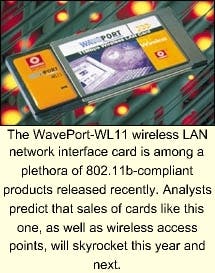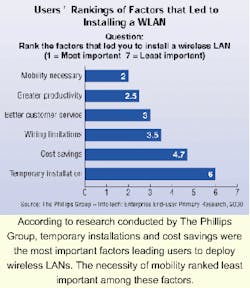Predictions for sharp growth continue as interoperability becomes common.
Patrick McLaughlin
For years, market researchers have forecast dramatic growth in the deployment of wireless local area network (WLAN) products and systems. But one stumbling block to widespread WLAN deployment has surrounded questions of interoperability. Particularly, WLAN products that comply with the Institute of Electrical and Electronics Engineers (IEEE-New York City) 802.11 specifications have not necessarily been interoperable with one another.
Today, more WLAN equipment makers than ever are achieving interoperability. And, perhaps not surprisingly, researchers continue to predict bold growth in the market sector. Last May, The Phillips Group (Parsippany, NJ) published a study predicting a 41% average annual growth rate for the WLAN industry through 2004, bringing the total market for wireless network interface cards (NICs) and access points (APs) to $1.7 billion that year.
Then, in January of this year, Cahners In-Stat Group (Scottsdale, AZ) published an even more bullish report. The research firm predicted that the WLAN market-including NICs, APs, and wireless bridges-will reach $3 billion by the end of next year.
Market-growth drivers
In its report, Cahners In-Stat notes that wireless NICs now typically cost less than $200, but are still much more expensive than 100Base-T NICs, which are about $45 apiece. "So the need for mobility must be high for companies to invest in WLAN technology," according to the study, authored by Gemma Paulo, voice and data industry analyst. And while WLANs simply cannot match the price and performance of wired networks, they are improving on both fronts, the study says.
The two research groups point out several technical and business factors that they expect will lead to this growth. In addition to citing the ability to provide greater mobility to workers, the firms say that putting security and reliability concerns to rest will lead to greater WLAN acceptance and deployment.
For example, the IEEE 802.11 workgroup will continue to develop security enhancements, says Cahners In-Stat. As for reliability, "The industry considers WLAN reliability to be a non-issue-that the technology has solved any reliability concerns," says Phillips Group analyst Shelly Tyler. "Eliminating reliability fears will open opportunities immediately."
Strategic alliances between computer and WLAN companies will also fuel growth, Tyler says. Cisco's $800 million acquisition of Aironet will be a significant spur, and Intel's $100 million investment in Symbol Technologies included development agreements to create WLAN products.
The Phillips report also points to Apple's decision to include Lucent's WLAN infrastructure in its laptops as a bellwether indicator. "Laptop manufacturers are incorporating WLAN cards, we've seen agreement on the 802.11 standard, faster-speed products, and price reductions-all will open the market," Tyler says.
Efforts at interoperability
Cahners In-Stat's Paulo says that the release of IEEE 802.11b-compliant products over the past 18 months "from several prominent network equipment and wireless vendors, including Cisco, Nortel, 3Com, Intel, Nokia, and Ericsson, drove WLAN gear into wider acceptance. The market will continue to thrive as vendors unveil new products with higher speeds, increased operability, and lower prices."
Higher-speed products include those that comply with the 802.11b standard, which specifies an 11-Mbit/sec data rate. 802.11b also specifies fallback speeds of 5.5, 2, and 1 Mbit/sec.
But perhaps the most significant technological developments in WLAN products concern interoperability. When the initial 802.11 standard was ratified in 1997, it did not guarantee product interoperability. Even the 802.11b specifications do not absolutely mandate interoperability. But a Silicon Valley-based organization called the Wireless Ethernet Compatibility Alliance (WECA-San Jose, CA), formed in 1999, has developed the WiFi (wireless fidelity) designation.
Since February 2000, Agilent Technologies' Silicon Valley Networking Lab has operated an independent test facility for WECA. Members can submit their WLAN products for interoperability testing; if they pass, the alliance grants a certification of interoperability to the vendor, which can then use the trademarked WiFi logo on packaging and advertising for the certified product. According to WECA, testing at the lab typically takes two to four days.
In late January, WECA announced that 79 products had passed the WiFi certification testing process. "WiFi's leadership is a validation that true, open standards lead to open market competition," says WECA vice chairman David Cohen. Of the 79 WiFi-certified products, Cohen says, "No other wireless LAN technology even comes close to this level and range of product availability."
Indeed, WECA has always had muscle at the core of its membership. The organization was founded in August 1999 by 3Com, Cisco Systems, Intersil, Lucent Technologies, Nokia, and Symbol Technologies.
But WECA is not the only organization aimed at furthering the WLAN cause. The Wireless LAN Association (WLANA) is an education-based association that includes many members in common with WECA, including 3Com, Cisco, Intersil, and Symbol Technologies. WLANA has positioned itself as an information center for consumers and potential consumers of WLANs.
Filling niches
Overall, a wireless LAN remains a niche application. Unlike some of the cabling industry's staunchest fiber-optic supporters, who swear that fiber will someday be the only medium reaching the desktop, WLAN proponents position the technology as primarily an extension of wired systems. Last year's Phillips Group report ranked factors that led to users implementing WLAN solutions. The top-ranking circumstance was a temporary installation, followed by cost savings. Wiring limitations and the necessity of mobility ranked lower in priority.
That study also focused on a specific application-voice over Internet Protocol (VoIP)-as a potential driver of WLAN deployment. "In our survey of enterprise decision-makers, nearly half of those without WLANs indicated that they would reconsider if offered a WLAN with VoIP capabilities," said analyst Tyler. "Furthermore, many potential users indicated that they would accelerate their purchases if this feature were included. We see an immediate marketing opportunity for those vendors already offering this capability. Our surveys indicate that while interest is high, awareness that VoIP is already available is relatively low. Vendors need to get the word out."
Futuregazing
Now that 11-Mbit/sec WLANs are fairly well accepted as today's (not tomorrow's) technology, what, then, is tomorrow's technology? Futuregazers say that a WLAN protocol that exceeds 50 Mbits/sec is on the horizon.
Such speed will be accomplished, technologists say, by using a different operating band. Currently, WLANs operate in the 2.4-GHz band. Development of WLAN systems that operate in the 5-GHz band is underway, and researchers anticipate data rates in excess of 50 Mbits/sec to result.
But considering the length of time it has taken WLANs to become mainstream, few are going out on the limb of estimating when we will see that type of speed in an enterprise WLAN.


